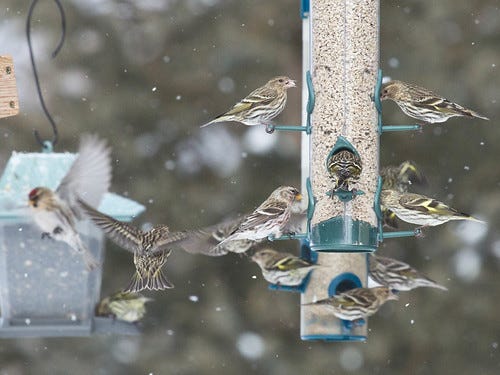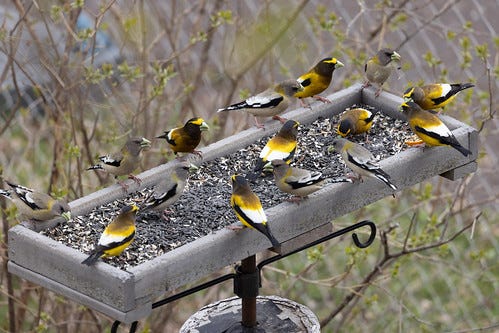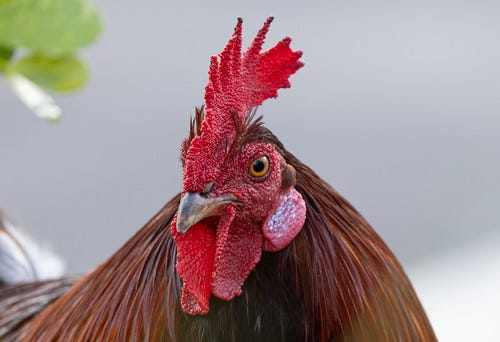Spring Bird Feeding Guidelines
Special precautions during a bird flu outbreak
(Listen to the radio version of the first part of this post here and the second part [about disposing of bird carcasses] here.)
When I was researching my 2006 book, 101 Ways to Help Birds, I delved deeply into how to provide backyard bird feeders and birdbaths responsibly. In addition to devoting several of the 101 chapters to improving backyard habitat and protecting birds from such hazards as windows, pesticides, cats, and dogs, I specifically focused on feeders and birdbaths in 13 of the 101 chapters. 1
Birds often collect in large numbers at feeders, which in natural situations is usually fine—finches and blackbirds in particular spend much of their annual cycle in tight flocks. But if one bird does get sick, its germs quickly spread to others. Unfortunately, unless bird feeding stations are kept meticulously clean, molds and bacteria can proliferate, meaning we ourselves may be the ones who caused a backyard disease outbreak.
In my neck of the woods, spring is especially dangerous. Unless people rake beneath feeders, rotting, moldy old seed, shells, and bird droppings on the ground can spread salmonella, botulism, and other diseases. Even in years when we’re not worried about an actual epidemic such as West Nile virus or bird flu, we have the same responsibilities to the birds we invite to our backyards that restaurant owners owe their human guests, to provide clean, safe food in a clean, safe environment.
With melting snows, spring rains, and warming temperatures, this is the time of year when we must be most diligent about feeder maintenance, and with our current epidemic of bird flu, we have to take more than just cleanliness into consideration as well.
Many of the informational websites about bird flu recommend closing down all our feeders for the duration, but so far I haven’t found a single authority who tracks wild bird data who goes to that extreme. Experts in human diseases don’t have a sense of the many different elements of bird feeding, and of course it’s better for them to err on the side of caution in giving advice. Even some bird organizations such as the International Crane Foundation concur:
There is currently little data to know how exactly HPAI is affecting passerines (perching birds, song birds, backyard birds). Due to these unknowns, it never hurts to be overly cautious and remove your feeders! We recommend checking your local authorities for guidance on continued use of bird feeders.
But authorities on bird feeding don’t see the issue in such black-and-white terms. The Cornell Lab of Ornithology discussion is much more nuanced:
There has been widespread transmission of avian flu to wild bird species including waterfowl and raptors. However, there have been relatively few documented cases of HPAI in songbirds and other typical feeder visitors to date, although this may change with increased testing or changes to the virus. That means there is currently a low risk of an outbreak among wild songbirds, and no official recommendation to take down feeders unless you also keep domestic poultry, according to the National Wildlife Disease Program. We do always recommend that you clean bird feeders and birdbaths regularly as a way to keep many kinds of diseases at bay.
We also always recommend that you follow any recommendations put out by your state government, even in cases where that advice conflicts with ours. The CDC’s page on avian influenza in birds compiles additional helpful information and resources, in English and Spanish.
My own recommendation remains the same as what I’ve been saying since bird flu became an issue: keep feeders clean, close down your feeding station if there is ANY evidence of a bird flu outbreak in neighborhood birds, and take a few other factors into account as well.
Domestic fowl, whether on large poultry farms or raised in backyards, are easily infected. If you or your neighbors are raising chickens, if large flocks of turkeys are regular visitors in your neighborhood, or if pigeons, crows, starlings, or blackbirds visiting your yard are likely to spend time near poultry, it would be wise to close any feeders that attract them.
Bird flu runs rampant in wild waterfowl and the birds that associate with them in wetlands, including grackles, Red-winged Blackbirds, and crows. If you’re near a wetland and any of those are regulars in your yard, or if neighbors are misguidedly feeding ducks or geese, it really would be safer to close down just about all your feeders while bird flu is an issue. Unless things change, I would not worry about the small window feeders that attract chickadees and other small songbirds, accommodating only one or two at a time.
If you find a dead bird in your yard, what should you do? During the West Nile virus outbreak, it was very easy for me to do a web search to find out where to get birds tested—indeed, someone brought me a dead, banded Blue Jay they’d found. After recording the band number, I brought the poor thing to a county office right here in Duluth to be tested. The test was positive, so I included that information on the band report.
West Nile virus was transmitted by mosquitoes, so handling carcasses was a simpler matter than those suspected of succumbing to Highly Pathogenic Avian Influenza, and at this point, with so little federal support and most state agencies overextended, it’s virtually impossible to find any facilities where carcasses can be tested. But without testing, there is no way to be certain that a given bird died of bird flu or another disease, and window strikes, birds hit by cars, and birds dropped by predators compound the confusion. All the official guidelines I’ve read insist that only qualified professionals with special protective gear should remove carcasses, but it’s virtually impossible to find a qualified professional to come take them away despite the fact that Bald Eagles and other scavengers and pets have been infected by infected carcasses. I have a dog and little grandson as well as squirrels and other wildlife to protect.
So if I find a dead bird in my own yard, I plan to use some of the same precautions I learned for handling groceries during the early days of Covid, before we understood how the disease was transmitted. I’ll put on disposable gloves and a mask, and using the inverted bag method I use when cleaning up after my dog, I’ll get the bird into a plastic bag, tie it tightly closed, double-bag it and toss in my disposable gloves, tie the outer bag tightly, dispose of it in the trash, and then wash my hands thoroughly and use disinfectant.
It's heartbreaking that, for the first time in my 73 years as an American citizen, I can’t trust the U.S. Fish and Wildlife Service and the Centers for Disease Control to lead the way through such a difficult wildlife and human health crisis. My hero Chandler Robbins must be rolling in his grave.
#41: Understand the pros and cons of bird feeding.
#42: Take precautions to keep your feeder birds safe from toxins and diseases.
#43: To deter hawks, close down your feeding station for a few weeks.
#44: Patronize feed stores that support conservation.
#45: Participate in citizen science feeder projects.
#46. Offer safe and appropriate birdseed.
#47: Offer peanut butter and nuts.
#48: Offer suet.
#49. Offer fruits and jellies.
#50. Provide water for drinking and bathing.
#51. Supply birds with calcium and other minerals.






Thanks Laura!
What are the birds in your first picture with yellow wing bars and yellow on the underside of their tail feathers? (We are moving and I made the mistake of packing our bird books already...)